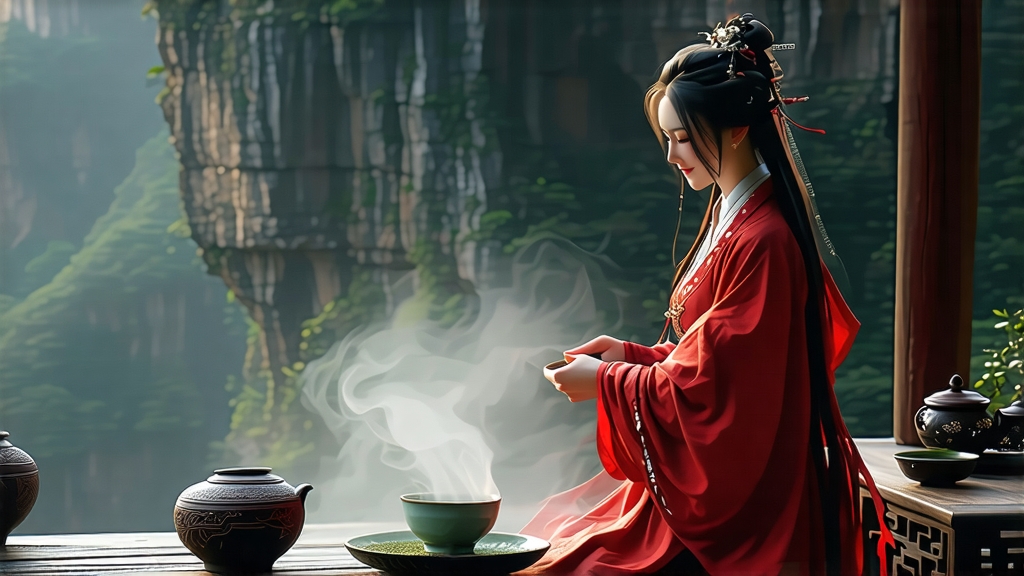
When Chinese tea lovers speak of “rock rhyme” – the mineral whisper that lingers on tongue and memory – they are almost always talking about Da Hong Pao, the legendary scarlet-robed oolong that grows on the vertiginous cliffs of Wuyi Mountain in northern Fujian. To the Western palate, accustomed to the bright brassiness of Ceylon or the malty heft of Assam, Da Hong Pao arrives as a revelation: a dark amber liquor that tastes first of roasted peach stone, then of orchid, then of the very stones from which it was born. This essay invites the international reader to walk the plank road that clings to Nine-Dragon Gorge, to smell the charcoal smoke curling from squat stone kilns, and to learn why, for four centuries, a few grams of authentic mother-tree leaf have been worth more than their weight in gold.
-
Myth, History, and Market
The name “Big Red Robe” is usually traced to a Ming-dynasty tale in which a gravely ill scholar was revived by tea plucked from six bushes halfway up Tianxin Cliff; the emperor, grateful, draped those bushes in scarlet silk to protect them from frost. Whether apocryphal or not, the story fixed the tea’s identity as imperial medicine. By the late Qing the original mother trees had become state tribute; in 1972 Mao Zedong presented 50 g to U.S. President Nixon, quietly announcing China’s diplomatic thaw. Today the six 350-year-old mother trees are preserved but no longer harvested; genetic cuttings taken in the 1980s created “purebred” qi dan bushes now cultivated across the 60 km² Wuyi Scenic Reserve. Meanwhile, skillful blending of selected cultivars (often Bei Dou #1, Que She, and Rou Gui) produces “commodity” Da Hong Pao that delivers the signature rock rhyme at everyday prices. Knowing the difference between mother-tree legend, purebred qi dan, and blended dhp is the first step toward informed appreciation. -
Terroir: The Cliffs That Breathe
Wuyi’s Danxia landform lays down thick red sandstone and conglomerate that weather into razor-sharp ridges. Morning mists rise from the Nine-Bend River, refracting weak sunlight onto bushes that root directly into fissures no wider than a hand. The soil is almost pure mineral: low in nitrogen, high in potassium and fluoride, with a porosity that forces roots to struggle, concentrating aromatic precursors. Day-night temperature differentials of 15 °C slow growth, thickening cell walls and increasing the ratio of aromatic alcohols to green-leaf volatiles. Locals summarize this unique interaction as “three cliffs, two mists, one stream,” arguing that without the cliff garden (yuan yan) there can be no yan yun – the rock rhyme that manifests as a cool, tingling sensation on the lateral edges of the tongue, reminiscent of wet slate after a summer storm. -
Cultivars in the Scarlet Family
Although “Da Hong Pao” functions as a brand, the Wuyi government recognizes three legally protected categories:
a) Mother-tree: no longer harvested, existing stocks stored in Beijing’s Palace Museum.
b) Purebred qi dan: clonal descendants grown inside the scenic reserve, yielding about 3 000 kg per year.
c) Blended dhp: skillfully balanced recipes using 3–7 complementary Wuyi cultivars, accounting for 95 % of market volume.
Each cultivar brings a voice to the choir: Bei Dou contributes deep charcoal bass, Rou Gui adds cinnamon mid-tones, and Que She supplies a high, floral soprano. Master blenders taste up to 200 infusions a day, adjusting proportions to ensure that the final tea “sings like a single bush even though it is a chorus.” -
Craft: The Eight-Stage Choreography
Plucking begins in late April when the third leaf half-opens; only the middle 4 cm of each shoot is taken. The eight stages that follow must be completed within 48 hours:
1) Solar withering: leaves are spread on bamboo trays set on cliff ledges for 30–45 min, softening cells through gentle enzymatic oxidation.
2) Indoor withering: trays rest on racks in a 24 °C room for 2–3 h; repeated tossing on the tray edges bruises leaf margins, initiating oxidation at 20 %.